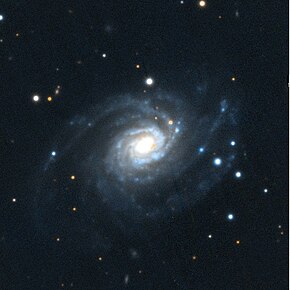

| NGC 753 | |
|---|---|

PanSTARRS image of NGC 753.
| |
| Observation data (J2000 epoch) | |
| Constellation | Andromeda |
| Right ascension | 01h57m 42.2s[1] |
| Declination | 35° 54′ 58″[1] |
| Redshift | 0.016355[1] |
| Heliocentric radial velocity | 4903 km/s[1] |
| Distance | 220 Mly (67 Mpc)[2] |
| Grouporcluster | Abell 262 |
| Apparent magnitude (V) | 12.97[1] |
| Characteristics | |
| Type | SAB(rs)bc[1] |
| Size | ~150,000 ly (46 kpc) (estimated)[1] |
| Apparent size (V) | 2.5 x 1.9[1] |
| Other designations | |
| MCG 6-5-66, PGC 7387, UGC 1437[1] | |
NGC 753 is a spiral galaxy[3] located 220 million light-years away[2] in the constellation Andromeda. The galaxy was discovered by astronomer by Heinrich d'Arrest on September 16, 1865[4] and is a member of Abell 262.[5][6][7][8][9][10]
NGC 753 has roughly 2-3 times more mass than the Milky Way[5] and is classified as a radio galaxy.[11][12][13]
NGC 753 contains two main arms that extend to 180° on either side of the galaxy.[14][15] From the two main arms, there are three larger and weaker arms that sub-divide into several branches.[14] This open structure of the arms may be due to the influence of NGC 759 which is a close companion of NGC 753[14][15] that lies 1.4 Mly (0.44 Mpc) away.[15]
NGC 753 has a supermassive black hole with an estimated mass of (2.2 ± 0.4) × 107 M☉.[16]
NGC 753 has hosted two supernovae,[17] SN 1954E which was discovered by Fritz Zwicky[18][19] on September 26, 1954[18][19][17][20] and AT 2018ddf which was discovered on July 5, 2018.[17][21][22] Both supernovae were of unknown types.[17][19][21][20][22]
|
| |||||||||||||
|---|---|---|---|---|---|---|---|---|---|---|---|---|---|
| |||||||||||||
| Stars |
| ||||||||||||
| |||||||||||||
| Star clusters |
| ||||||||||||
| Nebulae |
| ||||||||||||
| Galaxies |
| ||||||||||||
| |||||||||||||
| |||||||||||||